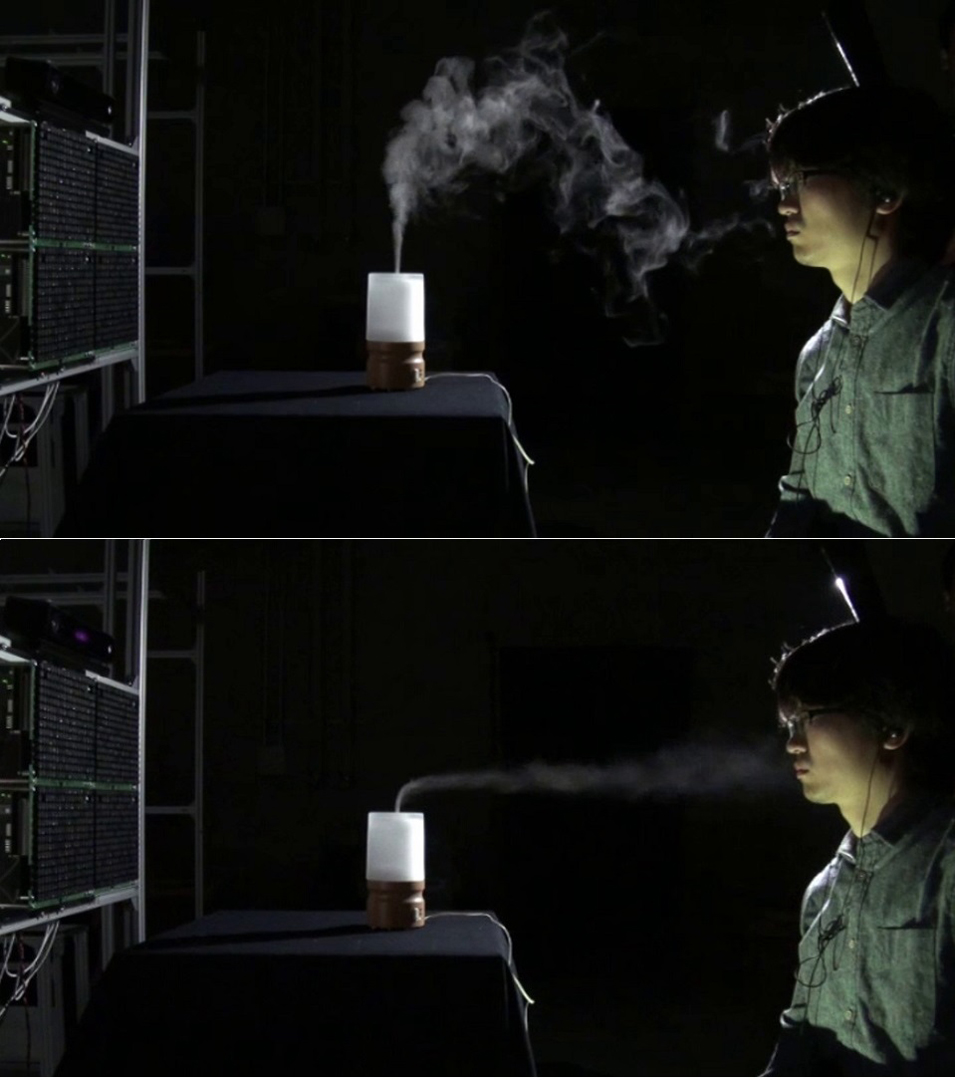“Interactive Midair Odor Control via Ultrasound-Driven Air Flow”
Conference:
Experience Type(s):
Title:
- Interactive Midair Odor Control via Ultrasound-Driven Air Flow
Organizer(s)/Presenter(s):
Description:
We propose a system for controlling aerial odor with ultrasound-driven straight air flows. The proposed system contains ultrasound transducers consolidated into a phased array so that the location and the orientation of the resulting flow can be arbitrarily steerable. The generated flows behave like virtual jets or fans in the air, which conveys airborne odorant materials toward desired locations including users’ faces, for example. Users do not have to wear any devices to enjoy olfactory experiences offered by the system. The situations where the proposed system works would be as follows (Fig. 1): (a) Remotely displaying prepared fragrance to users, (b) Remotely conveying odor of objects that already exist in the environment, and (c) Nullify odor emitted from objects placed near users by blowing it away before reaching them. Conventional olfactory systems mainly handle the first situation, while the others are rarely considered. This is presumably because it is sufficient to display preset fragrance with adequately controlled timings when used in virtual-reality (VR) applications. However, it is not only in the realm of VR applications that human olfactory sensation is important. For instance, scented teleexistence or anti-malodor system could be realized as practical examples of the second or third situations. Those example have not been well-investigated but would indeed potentially broaden the range of olfactory applications.
References:
[1]
J. Durnin, J. J. Miceli, and J. H. Eberly. 1987. Diffraction-free beams. Phys. Rev. Lett. 58 (Apr 1987), 1499–1501. Issue 15.
[2]
M. F. Hamilton and D. T. Blackstock. 1998. Nonlinear Acoustics. Academic Press, San Diego.
[3]
Keisuke Hasegawa, Liwei Qiu, Akihito Noda, Seki Inoue, and Hiroyuki Shinoda. 2017. Electronically steerable ultrasound-driven long narrow air stream. Applied Physics Letters 111, 6 (2017), 064104.
[4]
K. Hashimoto and T. Nakamoto. 2016. Tiny Olfactory Display Using Surface Acoustic Wave Device and Micropumps for Wearable Applications. IEEE Sensors Journal 16, 12 (June 2016), 4974–4980.
[5]
T. Hoshi, M. Takahashi, T. Iwamoto, and H. Shinoda. 2010. Noncontact Tactile Display Based on Radiation Pressure of Airborne Ultrasound. IEEE Transactions on Haptics 3, 3 (July 2010), 155–165.
[6]
H. Matsukura, T. Yoneda, and H. Ishida. 2013. Smelling Screen: Development and Evaluation of an Olfactory Display System for Presenting a Virtual Odor Source. IEEE Transactions on Visualization and Computer Graphics 19, 4 (April 2013), 606–615.
[7]
Y. Yanagida, S. Kawato, H. Noma, A. Tomono, and N. Tesutani. 2004. Projection based olfactory display with nose tracking. In IEEE Virtual Reality 2004. 43–50.





